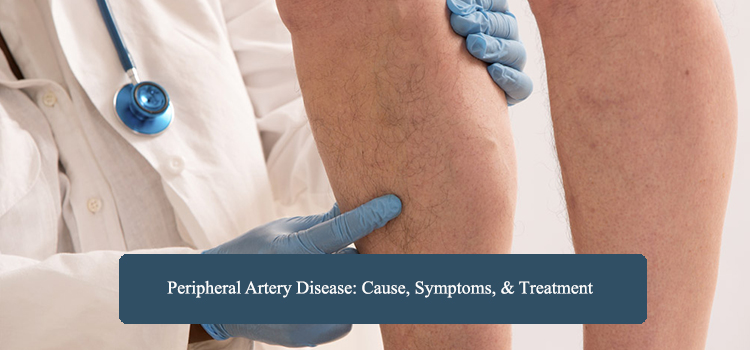Peripheral Artery Disease: Cause, Symptoms, & Treatment

Peripheral Artery Disease (PAD) aka Peripheral Vascular Disease
This guide focuses on Peripheral Artery Disease in which the blood flow is reduced in the limbs. We will discuss the causes, symptoms and treatments that can help widening or reopening these arteries.
Peripheral Artery Disease is a blocked circulatory condition in which the blood supply in the limbs is reduced because of the narrowed blood vessels in the patient. This condition is a sign of plaque buildup on the walls of arteries that closes the path for the blood to flow. This plaque deposit is made from fat, calcium, fibrous tissue, cholesterol and other waste substances that are found in blood.
The condition in which the plaque buildups in the arteries is called atherosclerosis. Over time, this plaque hardens, creating blood clots and blocking the blood to flow smoothly in the body. This tampers with the usual flow of oxygen-rich blood preventing it from reaching to all organs and travel through the body.
PAD typically spreads in the arteries present in the legs, but it can also affect the patient’s heart, kidneys, arms, and stomach. This condition progresses with age and might get adverse if the patient is a smoker or has diabetes.
Normal Artery VS Artery With Plaque Walls
Arteries are a part of the circulatory system that carries oxygenated blood from the heart to other organs, tissues throughout the body. The usual flow of blood in the body, allows the organs to function correctly.
Blocked or reduced supply of blood in the legs can make the patient’s limbs numb or induce intense pain. It can also increase the risk of infection. In severe cases, the blocked flow of blood can even cause tissue death (gangrene). In extreme cases, PAD might also cause leg amputation.
Causes
PAD is mostly caused because of atherosclerosis. Atherosclerosis occurs because of plaque build-up in the arteries. The exact cause of this condition isn’t known. But the following factors can increase the chances of building inner layer in the arteries:
• Smoking
• High cholesterol and fats count in the blood
• High Blood Pressure
• Increased amount of sugar count in the blood because of diabetes or insulin resistance.
When damage occurs in the body, it kickstarts a healing process. The healing might be the reason for plaque buildup in the arteries in some cases.
When the section of this plaque ruptures or break opens, it leads to the generation of blood clots on the site.These blood clots and plaque narrow the veins disabling the oxygen-rich blood to flow smoothly in the body.
Symptoms
A patient might experience the following signs if he/she is affected by Peripheral Artery Disease:
• Painful cramping in thighs and hips
• Coldness in the foot or lower legs
• Reduced motion in the legs
• Numbness or Weakness in Leg
• Change in color on the skin of the legs
• Slower hair growth or hair loss on legs
• Sores on feet, legs, or toes
• Shiny skin on legs
• No pulse in legs or feet
• Erectile Dysfunction
Risk Factors
• Diabetes
• Obesity
• High Blood Pressure
• High Cholesterol
• Increasing Age
• Family History with peripheral artery disease
Treatment
Most cases of PAD are successfully treated by making a few alterations in daily routine including tobacco cessation, regular exercise, and adopting a healthy diet. However, when this doesn’t seem to work medication and surgery can be considered.
Self-Care
Physical Exercise
Indulging in aerobic activity for 30 minutes at least five days a week can help in improving patients cardiovascular health.
Quit Smoking
Activities that might put any burden on your arteries should be avoided which includes tobacco use and alcohol consumption.
Healthy Diet
The patient can adopt a diet that can help them in reducing their fat and sugar, while increasing intake of fish, fruits and vegetables.
Medications
Statin – prevent the liver from producing harmful cholesterol
Vasodilator – helps in widening blood vessels
Blood Thinners – helps in dissolving existing blood clots, while preventing the formation of any new clots.
Medical Procedures
Bypass Grafting – is considered when the blood flow in the limbs is blocked. In this surgery, a synthetic tube, or a blood vessel from another part of the patient's body is used for constructing a graft. This graft is placed around the blocked section of the artery, creating a new route for the blood to flow through. PAD can’t be cured using Bypass graft, but the blood supply can be increased in the affected limb using this method.
Angioplasty & Stent Placement
Angioplasty is a nonsurgical procedure that is performed using a catheter (a flexible, thin tube) with a balloon attached to it that is inserted into the blocked artery from the upper thigh of the patient, which is inflated as it reaches the affected area opening the artery by compressing the plaque on the walls of the artery.
In some cases, a stent (a mesh tube) is placed inside the patient during angioplasty to keep the artery open. This stent is covered with medicines that prevent it from getting blocked again.
Atherectomy – is a used for the removal of plaque buildup from the artery. This procedure is also performed using a catheter, which is used for inserting a small sharp device in the blocked artery, for cutting off the plaque. The pieces of the plaque are removed from the artery using the catheter. Atherectomy can also be performed using a laser that can help in dissolving the blockage.
FAQs
Can peripheral artery disease cause death?
Depending on the severity of the case, a patient might die from PAD, if the blood supply is reduced in the arteries of the heart or brain. Thankfully, there are multiple treatment options available for PAD that can help in reducing its symptoms immediately.
What is the cost of angioplasty in India?
The patient can cover the cost of his treatment, travel and stay in India, within a budget of USD 4,200 in India for single stend. However, the initial cost of the procedure is subject to change depending on the position of the blocked artery.
Explore Medmonks.com to learn more about Peripheral Artery Disease, and it’s treatment options available in India.





